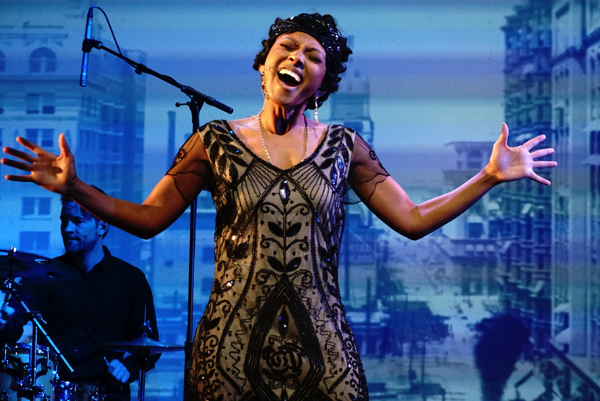
The Midnight Company’s 'St. Louis Woman' Presents the Bright Lights from This Not-So-Big City
By CB Adams
The Guess Who gave us “American Woman.” The Doors gave us “L.A. Woman.” And now Joe Hanrahan and The Midnight Company bring it all back home with the world premiere of “St. Louis Woman,” a play with music starring local singer LAKA.
“St. Louis Woman,” written and directed by Joe Hanrahan, the company’s artistic director, is a well-intentioned one-woman show with the goal to present, as it’s billing states, “The City. The Songs. The Women.” To best describe “St. Louis Woman,” it’s best to define what it is. It may be an entertainingly educational story told – or more importantly, sung – about St. Louis’ legacy of successful women artists. Or it may be an educationally entertaining performance focused on a hundred-plus years of artistic boosterism. As LAKA exclaims early in the first half: “Booze. Broads. Bibles!”
This production is a nice reminder that St. Louis has incubated a fair share of iconic, history-making women, exemplified by LAKA’s portrayals of Josephine Baker, Willie Mae Ford Smith, Tina Turner, Katherine Dunham, Maya Angelou and Ann Peebles, among others. St. Louis is the portal through which these women are presented, but the city itself isn’t portrayed as the nurturing environment that its brightest stars might seem to indicate. These women were successful in spite of the sexism, racism, violence and abuse they experienced here – all of which aren’t exclusive to St. Louis, anyway.
“St. Louis Woman” is designed as an immersive experience that includes sound effects and a backdrop showing a constant stream of historic photographs and film clips that help illustrate LAKA’s songs and portrayals. These elements augment and enhance her performance – all thanks to video design by Michael Musgrave-Perkins, lighting design by Tony Anselmo and overall production design by Kevin Bowman.
All of this visual and aural stimuli provides an environment, an entertaining ecosystem, for LAKA’s portrayals of these divergently talented artists. Onstage, she is backed by her go-to musicians, Corey Patterson, who provides keyboards as well as music direction, and percussionist Gabe Bonfili. On opening night, this unassuming twosome was obviously comfortable backing LAKA. Patterson and Bonfili were often so effective it was almost easy to forget they were on stage – to their credit.
“St. Louis Woman” is an ambitious endeavor that strives to weave characters, history, personal asides, interesting factoids and Wikipedia-level research into a compelling narrative. It requires LAKA, in both first- and third-person narration as well through song, to pivot from character to character to character for almost two hours. That’s a tall order for even the most experienced actors, and one that obviously stretched LAKA’s acting (and sometimes dancing) skills to her limits. The costumes, which she changed into often and deftly, are one of the show’s strengths. Thanks to the design by Liz Henning, the costumes helped with the characterizations and provided the perfect visual clues. Henning’s take on Josephine Baker’s iconic banana skirt was spot on.
I was hopeful that LAKA could achieve the same type of engaging, in-the-moment characters that Whoopi Goldberg conjured in her one-woman show from the early 80s, “The Spook Show.” Although LAKA’s acting grasp falls somewhat short of this show’s intricate script, it is her singing that saves the show from its expository, middle-school field trippiness. LAKA was fully on top of the entire range of songs she performed. And an impressive range it was, including “Jai' Deux Amours,” “The Times They Are A' Changin’,” “Nutbush City Limits,” “Proud Mary,” “Rescue Me” and, of course, “St. Louis Blues.”
Opening night on Thursday, Oct. 7 had the usual opening-night glitches, including flubbed lines, hard-to-hear dialogue, mic issues and miscues, but, hey, that’s why we love live theater. All can be forgiven.
By the conclusion of “St. Louis Woman,” I wondered whether this city was all that important to the ultimate success of Willie Mae, Maya and Katherine, et al. It’s like one of Ann Peebles’ albums covers, stating she was a St. Louis woman, but with a Memphis soul. There isn’t really a St. Louis sound – at least not like the distinctive styles associated with Detroit, Baltimore or Memphis.
This show’s icons may have reached stardom – oftentimes international stardom – regardless of the St. Louis association. All found their fame outside of our city limits. It’s no one’s fault that St. Louis women (at least the ones presented in this show) find their souls lie elsewhere. And maybe that’s the unintended message in “St. Louis Woman.” Rather than “George Washington slept here,” we get “Ike hurt Tina here.” The good news is that we still got Tina, and the rest of the St. Louis women, anyway.
This is that kind of show. Come for the songs. Stay for the songs. And if along the way you learn a thing or two about St. Louis and the exceptional women it has helped form, then it’s a good thing – and well worth the price of admittance.
The Midnight Company presents “St. Louis Woman” from October 6 - 22 at the .ZACK theatre, with performances Thursdays/Fridays and Saturdays at 8pm, and Sunday matinees October 9 and 16 at 2pm. For more information, visit The Midnight Company web site.




